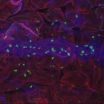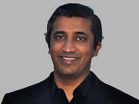(Press-News.org) NEW YORK, Feb. 14, 2013 – Nitric oxide, the versatile gas that helps increase blood flow, transmit nerve signals, and regulate immune function, appears to perform one more biological feat— prolonging the life of an organism and fortifying it against environmental stress, according to a new study.
The study reveals that a roundworm called Caenorhabditis elegans, an animal widely used in laboratory studies of aging, lives significantly longer when fed bacteria capable of manufacturing nitric oxide. The tantalizing observation points to one of the mechanisms by which the microbiome, the trillions of microbial cells inhabiting our bodies, may play a vital role in our health.
Our own nitric oxide levels decrease as we get older, a decline that may contribute to normal aging, says Evgeny Nudler, PhD, the Julie Wilson Anderson Professor of Biochemistry at NYU Langone Medical Center, who led the new study. Supplemental bacteria, he speculates, might provide a healthy boost by supplying humans with some of the missing compound.
"In worms, we now know that bacteria can use nitric oxide not only to their own advantage but also to provide their host with a beneficial response, and the same thing could be true in a human gut," says Dr. Nudler. "It may well be the case that our commensal bacteria control some of our genes, at least in the gut, to protect those cells against stress and age-related decline." Commensal bacteria provide a benefit to the organisms they colonize.
Although humans and many other organisms have the enzyme needed to produce nitric oxide, C. elegans does not. Instead, Dr. Nudler and his team report in the February 14th online issue of Cell that the worm can "hijack" the compound from the soil-dwelling Bacillus subtilis bacterium that is not only a favored food but also a common colonist within its gut. This resourcefulness, Dr. Nudler says, partially explains why worms fed B. subtilis live roughly 50 percent longer than counterparts fed Escherichia coli, which does not produce the compound.
In the new study, the average C. elegans lifespan increased by nearly 15 percent, to about two weeks, when researchers fed the worms nitric oxide-producing B. subtilis bacteria, compared to worms fed mutant B. subtilis with a deleted nitric oxide production gene. The research group also used fluorescent sensors to show that C. elegans does not make its own nitric oxide gas. When the worms were fed normal B. subtilis bacteria, however, the fluorescent signal appeared in their guts.
Fluorescent labeling and other tests also demonstrated that B. subtilis-derived nitric oxide penetrated the worms' tissues, where it activated a set of 65 genes. Some had been previously implicated in stress resistance, immune response, and increased lifespan, though others have unknown functions. Importantly, the researchers showed that two well-known regulatory proteins were essential for activating all of the genes.
"What we found is that nitric oxide gas produced in bacteria inside the worms diffuses into the worm tissue and activates a very specific set of genes acting through two master regulators, hsf-1 and daf-16, resulting in a high resistance to stress and a longer life," Dr. Nudler says. "It's striking that a small molecule produced by one organism can dramatically affect the physiology and even lifespan of another organism through direct cell signaling."
As part of nitric oxide's expansive repertoire, Dr. Nudler's lab previously showed how dangerous pathogens can exploit the molecule to fight off antibiotics. Despite its versatility, the new research suggests that nitric oxide is only one of multiple beneficial molecules produced by B. subtilis, Dr. Nudler says. His lab plans to look more closely at other potential mechanisms by which commensal bacteria can promote health and longevity, using the powerful and easily manipulated C. elegans system as a model.
INFORMATION:
The study co-authors include Ivan Gusarov, Laurent Gautier, Olga Smolentseva, and Ilya Shamovsky from the Department of Biochemistry and Molecular Pharmacology at NYU Langone Medical Center; and Svetlana Eremina and Alexander Mironov from the State Research Institute of Genetics and Selection of Industrial Microorganisms in Moscow, Russia.
The research was supported by the National Institutes of Health, the Biogerontology Research Foundation, and the Dynasty Foundation.
About NYU Langone Medical Center
NYU Langone Medical Center, a world-class, patient-centered, integrated, academic medical center, is one on the nation's premier centers for excellence in clinical care, biomedical research and medical education. Located in the heart of Manhattan, NYU Langone is composed of four hospitals – Tisch Hospital, its flagship acute care facility; the Hospital for Joint Diseases, one of only five hospitals in the nation dedicated to orthopaedics and rheumatology; Hassenfeld Pediatric Center, a comprehensive pediatric hospital supporting a full array of children's health services; and the Rusk Institute of Rehabilitation Medicine, the world's first university-affiliated facility devoted entirely to rehabilitation medicine– plus NYU School of Medicine, which since 1841 has trained thousands of physicians and scientists who have helped to shape the course of medical history. The medical center's tri-fold mission to serve, teach and discover is achieved 365 days a year through the seamless integration of a culture devoted to excellence in patient care, education and research. For more information, go to www.NYULMC.org.
A little molecule's remarkable feat -- prolonging life
Bacteria producing nitric oxide extend life in roundworms
2013-02-14
ELSE PRESS RELEASES FROM THIS DATE:
Vision restored with total darkness
2013-02-14
Restoring vision might sometimes be as simple as turning out the lights. That's according to a study reported on February 14 in Current Biology, a Cell Press publication, in which researchers examined kittens with a visual impairment known as amblyopia before and after they spent 10 days in complete darkness.
Researchers Kevin Duffy and Donald Mitchell of Dalhousie University in Canada believe that exposure to darkness causes some parts of the visual system to revert to an early stage in development, when there is greater flexibility.
"There may be ways to increase ...
New study of the molecular roots of recurrent bladder infections could lead to a vaccine
2013-02-14
Urinary-tract infections are the second most common bacterial infection in humans, and many of them are recurrent. A study published by Cell Press on February 14th in the journal Immunity reveals the cellular and molecular basis of recurrent bladder infections and suggests possible treatment strategies, such as vaccines, to prevent this common problem.
"Our study shows for the first time that the bladder is unable to mount an effective immune response to bacteria, which could explain the high frequency of recurrent infections," says senior study author Soman Abraham ...
Roots of language in human and bird biology
2013-02-14
BOSTON, MA -- The genes activated for human speech are similar to the ones used by singing songbirds, new experiments suggest.
These results, which are not yet published, show that gene products produced for speech in the cortical and basal ganglia regions of the human brain correspond to similar molecules in the vocal communication areas of the brains of zebra finches and budgerigars. But these molecules aren't found in the brains of doves and quails -- vocal birds that do not learn their sounds.
"The results suggest that similar behavior and neural connectivity for ...
2 Cell studies reveal genetic variation driving human evolution
2013-02-14
VIDEO:
A pair of studies published by Cell Press on February 14th in the journal Cell sheds new light on genetic variation that may have played a key role in human...
Click here for more information.
A pair of studies published by Cell Press on February 14th in the journal Cell sheds new light on genetic variation that may have played a key role in human evolution. The study researchers used an animal model to study a gene variant that could have helped humans adapt to humid ...
Bilingual babies know their grammar by 7 months
2013-02-14
Babies as young as seven months can distinguish between, and begin to learn, two languages with vastly different grammatical structures, according to new research from the University of British Columbia and Université Paris Descartes.
Published today in the journal Nature Communications and presented at the 2013 Annual Meeting of the American Association for the Advancement of Science (AAAS) in Boston, the study shows that infants in bilingual environments use pitch and duration cues to discriminate between languages – such as English and Japanese – with opposite word ...
First animal model of recent human evolution
2013-02-14
The first animal model of recent human evolution reveals that a single mutation produced several traits common in East Asian peoples, from thicker hair to denser sweat glands, an international team of researchers reports.
The team, led by researchers from Harvard Medical School, Harvard University, the Broad Institute of MIT and Harvard, Massachusetts General Hospital, Fudan University and University College London, also modeled the spread of the gene mutation across Asia and North America, concluding that it most likely arose about 30,000 years ago in what is today ...
Defect in immune memory may cause repeat bladder infections
2013-02-14
DURHAM, N.C. – Recurrent bladder infections, which are especially common among women, may result from a defect among the bladder's immune fighters that keeps them from remembering previous bacterial infections. The immune memory lapse can hamper a timely and effective attack, according to researchers at Duke Medicine and Duke-National University of Singapore.
Their study, which involved mice, may provide a new route to develop vaccines and treatments for urinary tract infections, which are the second-most common infection and account for more than 8 million health care ...
Discovery in HIV may solve efficiency problems for gene therapy
2013-02-14
A research team from Case Western Reserve University School of Medicine has discovered an approach that could make gene therapy dramatically more effective for patients.
Led by professor Eric Arts, PhD, the scientists discovered that the process of gene therapy is missing essential elements thereby reducing the effectiveness of this treatment. Re-introducing this element into their model system suggests that improvements for gene therapy areon the horizon.
The findings are detailed in the article, "A new genomic RNA packaging element in retroviruses and the interplay ...
Study tracks leukemia's genetic evolution, may help predict disease course, tailor care
2013-02-14
BOSTON AND CAMBRIDGE, Mass.––Tumors are not factories for the mass production of identical cancer cells, but are, in reality, patchworks of cells with different patterns of gene mutations. In a new study, researchers at Dana-Farber Cancer Institute and the Broad Institute show, more fully than ever before, how these mutations shift and evolve over time in chronic lymphocytic leukemia (CLL) – providing a strobe-like look at the genetic past, present, and future of CLL tumors.
Their report, which will be published online today by the journal Cell, suggests that evolution ...
Gene invaders are stymied by a cell's genome defense
2013-02-14
Gene wars rage inside our cells, with invading DNA regularly threatening to subvert our human blueprint. Now, building on Nobel-Prize-winning findings, UC San Francisco researchers have discovered a molecular machine that helps protect a cell's genes against these DNA interlopers.
The machine, named SCANR, recognizes and targets foreign DNA. The UCSF team identified it in yeast, but given the similarity of yeast and human cells, comparable mechanisms might also be found in humans, where they might serve to lower the burden of inherited human disease and death, the researchers ...
LAST 30 PRESS RELEASES:
First Editorial of 2026: Resisting AI slop
Joint ground- and space-based observations reveal Saturn-mass rogue planet
Inheritable genetic variant offers protection against blood cancer risk and progression
Pigs settled Pacific islands alongside early human voyagers
A Coral reef’s daily pulse reshapes microbes in surrounding waters
EAST Tokamak experiments exceed plasma density limit, offering new approach to fusion ignition
Groundbreaking discovery reveals Africa’s oldest cremation pyre and complex ritual practices
First breathing ‘lung-on-chip’ developed using genetically identical cells
How people moved pigs across the Pacific
Interaction of climate change and human activity and its impact on plant diversity in Qinghai-Tibet plateau
From addressing uncertainty to national strategy: an interpretation of Professor Lim Siong Guan’s views
Clinical trials on AI language model use in digestive healthcare
Scientists improve robotic visual–inertial trajectory localization accuracy using cross-modal interaction and selection techniques
Correlation between cancer cachexia and immune-related adverse events in HCC
Human adipose tissue: a new source for functional organoids
Metro lines double as freight highways during off-peak hours, Beijing study shows
Biomedical functions and applications of nanomaterials in tumor diagnosis and treatment: perspectives from ophthalmic oncology
3D imaging unveils how passivation improves perovskite solar cell performance
Enriching framework Al sites in 8-membered rings of Cu-SSZ-39 zeolite to enhance low-temperature ammonia selective catalytic reduction performance
AI-powered RNA drug development: a new frontier in therapeutics
Decoupling the HOR enhancement on PtRu: Dynamically matching interfacial water to reaction coordinates
Sulfur isn’t poisonous when it synergistically acts with phosphine in olefins hydroformylation
URI researchers uncover molecular mechanisms behind speciation in corals
Chitin based carbon aerogel offers a cleaner way to store thermal energy
Tracing hidden sources of nitrate pollution in rapidly changing rural urban landscapes
Viruses on plastic pollution may quietly accelerate the spread of antibiotic resistance
Three UH Rainbow Babies & Children’s faculty elected to prestigious American Pediatric Society
Tunnel resilience models unveiled to aid post-earthquake recovery
Satellite communication systems: the future of 5G/6G connectivity
Space computing power networks: a new frontier for satellite technologies
[Press-News.org] A little molecule's remarkable feat -- prolonging lifeBacteria producing nitric oxide extend life in roundworms






